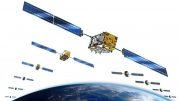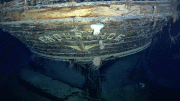
(Click on the image for a larger annotated map) This mosaic depicts a crater-covered area extending across the lunar south pole. Composed of roughly 40 individual images captured between December 2005 and March 2006, it spans an area of about 500 x 150 km (310 x 93 mi). Credit: ESA/SMART-1/AMIE camera team; image mosaic: M. Ellouzi/B. Foing
This newly released mosaic shows a crater-riddled region at the lunar south pole of our Moon.
The dark and shadowed regions of the Moon fascinate astronomers and Pink Floyd fans alike. Our Moon’s rotation axis has a tilt of 1.5º, meaning that some parts of its polar regions never see sunlight – the bottoms of certain craters, for example, are always in shadow.
Imaged during summertime in the Moon’s southern hemisphere by the Advanced Moon Imaging Experiment on ESA’s SMART-1 spacecraft, this mosaic shows a crater-riddled region spanning the lunar south pole. It is made up of around 40 individual images taken between December 2005 and March 2006, and covers an area of about 500 x 150 km (310 x 93 mi).
The craters visible here include (from right to left, starting with the largest round shape visible in the frame) the Amundsen, Faustini, Shoemaker, Shackleton, and de Gerlache craters.
Amundsen is the largest of the bunch at 105 km (65 mi) across, followed by Shoemaker (50 km or 31 mi), Faustini (39 km or 24 mi), de Gerlache (32 km or 20 mi), and Shackleton (19 km or 12 mi). This group of craters all look different, see varying levels of sunlight, and display a range of interesting properties.
Shackleton crater, the small circle visible to the left of the center, contains the south pole within its rim. By using SMART-1 images to explore the number of small impact craters scattered on the smooth, dark surface surrounding Shackleton, scientists have found this crater to be older than the Apollo 15 landing site (3.3 billion years), but younger than the Apollo 14 site (3.85 billion years).
Shoemaker crater, visible to the upper left of the center, is notable because of the 1999 Lunar Prospector mission, which deliberately crashed into the crater in an attempt to create a detectable plume of water vapor by heating any water ice that may have been present. No vapor was spotted. However, all is not lost; some permanently shadowed regions have been in the dark for millions of years, and it is still possible that they may contain water ice deposited by comets and water-rich asteroids.
Studying the dark depths of these craters could tell us not just about the history of the Moon, but also about Earth, helping us to understand better how, and how much, water and organic material may have been transferred from the Moon to Earth over its history.









Be the first to comment on "New Mosiac of the Moon’s South Pole"